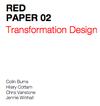User-centred design becomes transformation design – updated
It could be key to solving many of society’s most complex problems. But the community of practice is small, and its emergence has already caused controversy among those who argue that it’s not design – because here’s the rub: it doesn’t look or feel much like design in the familiar sense of the word. The outputs aren’t always tangible and beautiful, and may be adapted and altered by people as they use them. It is far from the paradigm of the master-designer.
The UK Design Council has just published a paper on transformation design (pdf, 193 kb, 33 pages).
The paper begins to set out the characteristics of the emergent discipline of Transformation Design. It identifies a nascent but growing community of practice. It highlights an under-supply of designers equipped to work in this way. And it explores the market for, and the challenges facing, designers who are starting to work in this new discipline.





[…] in design, I need only refer to the paper that Colin Burns, Hilary Cottam et al. published in early 2006 – currently available […]
[…] nel design, basta fare riferimento al paper che Colin Burns, Hilary Cottam ed altri hanno pubblicato a inizi del 2006 – attualmente disponibile […]